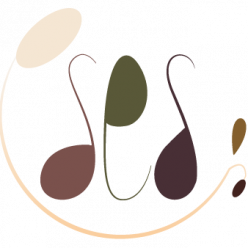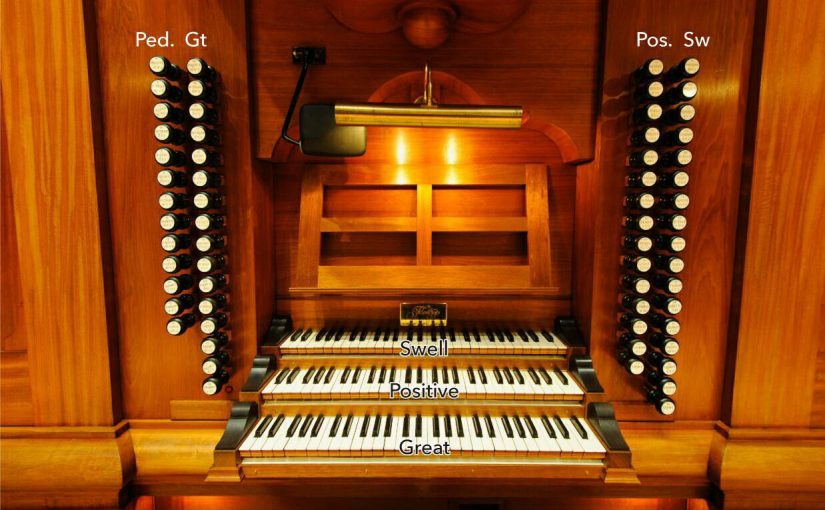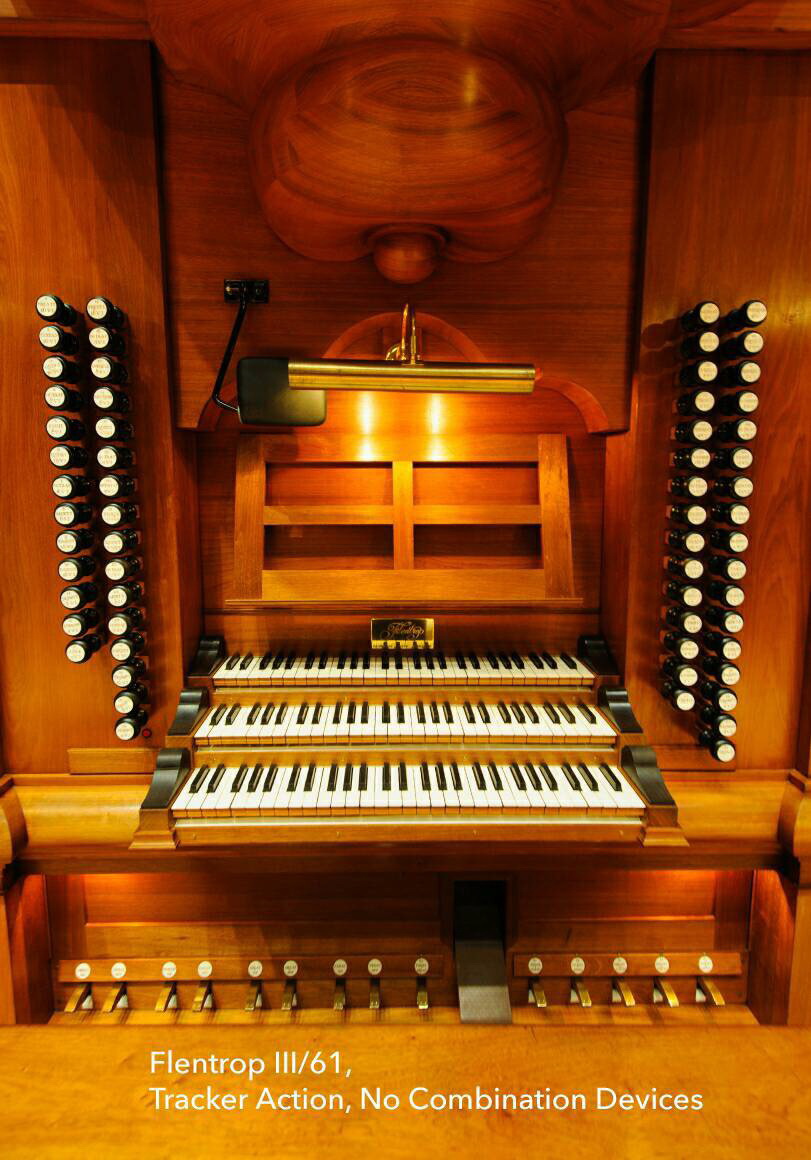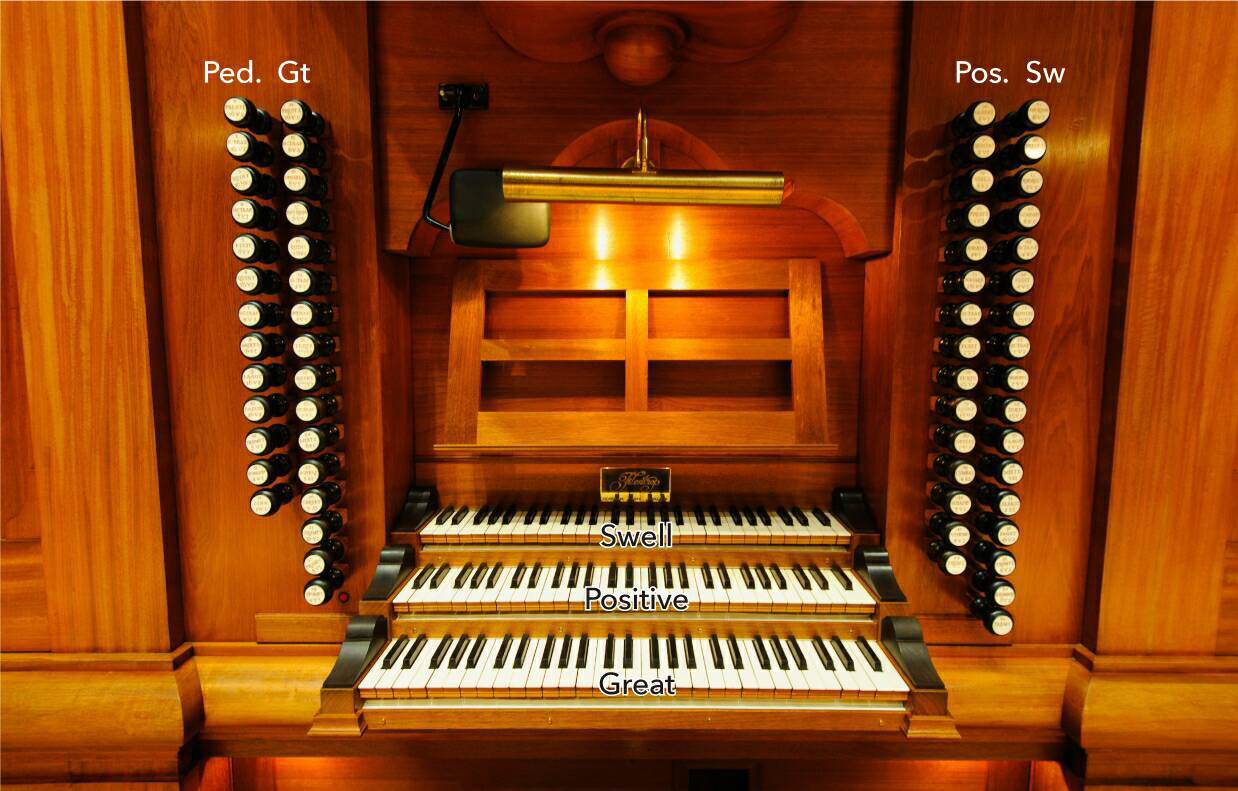看過管風琴現場演奏的人,往往驚嘆於其音色的莊嚴宏大,還有就是演奏家的「忙碌」了。對於管風琴這個本身就像藝術品的樂器,如果了解它的構造原理,就明白為什麼音色會如此特殊、還有為什麼會如此難以駕馭。在連續幾篇關於此次「第一屆亞洲管風琴大賽」比賽曲目導聆後,相信愛樂者對於曲子都有了一定的熟悉度。其實對於參賽者來說,還有一個困難的關卡,就是國家音樂廳這架雄偉的傳統機械式管風琴了。到底傳統機械式和電動氣動式的差異在那裏?演奏時詮釋不同作品的優異之處為何?此次比賽的執行委員謝安來博士以他在國家音樂廳彈奏的經驗,作了一篇詳細的介紹,同時讓大家更進一步了解管風琴樂器的複雜與多變,相信會更加為它深深著迷!
The Flentrop Organ at the National Concert Hall (台北國家音樂廳Flentrop管風琴)
A pipe organ is a musical instrument that produces sound by pumping pressurized air through organ pipes selected via keyboards or pedalboard. Because each pipe produces a single pitch, the pipes are provided in sets called ranks, each of which has a common timbre and volume throughout the keyboard compass. Most organs have multiple ranks of pipes of differing timbre, pitch, and volume that the player can employ singly or in combination through the use of controls called stops.
管風琴是一種透過鼓風機送風吹響音管,並配合雙手及腳彈奏鍵盤的一種樂器。當手指按下琴鍵後,與該鍵相對應的音管的管塞就會打開,當氣流通過吹響音管時則發出樂音,每組音管皆可發出相同的音質和音量,通常每座管風琴都有多組不同音色的音栓,而管風琴家演奏時則藉由組合各種不同的音栓來控制音色和音量。
A pipe organ has one or more keyboards (called manuals) played by the hands, and a pedalboard played by the feet; each keyboard has its own group of stops. The keyboard(s), pedalboard, and stops are housed in the organ’s console. The organ’s continuous supply of wind allows it to sustain notes for as long as the corresponding keys are pressed, unlike the piano and harpsichord whose sound begins to dissipate immediately after it is played.
管風琴通常有多個鍵盤,用手彈奏的手鍵盤及用腳演奏的腳鍵盤;每個鍵盤皆配置了多組音栓。而手鍵盤腳鍵盤和音栓皆位於演奏台上。當任何琴鍵被按住後,透過持續的風壓而吹響音管,而手指放開後聲音則立刻消失;鋼琴及大鍵琴任何琴鍵被彈奏後,聲音可以持續一段時間。
During the Renaissance and Baroque periods, the organ’s tonal colors were influenced by musical instruments of that time. Organ builders incorporated stops that imitated various instruments, such as the krummhorn and the viola da gamba. The Baroque period is often thought of as organ building’s “golden age,” as virtually every important refinement was brought to a culminating art.
巴洛克時期被譽為管風琴的黃金時代,因為在文藝復興及巴洛克時期,管風琴的音色深深的受到當時樂器的影響,製琴師會模仿庫莫號(一種古雙簧樂器)和古提琴的音色將他們用於音栓上,此時期每次重要的變革都將管風琴推向更高峰更為精緻化。
During the Romantic period, the organ became more symphonic, capable of creating a gradual crescendo. New technologies and the work of organ builders such as Eberhard Friedrich Walcker, Aristide Cavaillé-Coll, and Henry Willis made it possible to build larger organs with more stops, more variation in sound and timbre, and more divisions. Enclosed divisions became common, and registration aids were developed to make it easier for the organist to manage the great number of stops. The desire for louder, grander organs required that the stops be voiced on a higher wind pressure than before. As a result, a greater force was required to overcome the wind pressure and depress the keys. To solve this problem, Cavaillé-Coll configured the English “Barker lever” to assist in operating the key action.
浪漫派時期的管風琴變為更交響化了,音色像交響樂一樣的豐富,聲音能夠由弱漸強。 此時的管風琴製琴師沃克、卡發利耶-柯爾及威理斯有了新技術可以建造更大型的管風琴,音栓的多樣性及音色變化也更為豐富。 管風琴家也因為音栓設置的輔助發明而能夠運用更多的音栓組合。此時期的管風琴能發出更宏亮而莊嚴的聲音,因而更大的風壓變的不可或缺,想當然爾風壓加大,演奏者則須用更大的力量彈奏。 為了解決這個問題,管風琴製琴師卡發利耶-柯爾用了英式的巴克槓桿原理使鍵盤變為更好彈奏。
Organ builders began to lean towards specifications with fewer mixtures and high-pitched stops. They preferred to use more 8’ and 16’ stops in their specifications and wider pipe scales. These practices created a warmer, richer sound than was common in the 18th century. Organs began to be built in concert halls, and composers such as Camille Saint-Saëns and Gustav Mahler used the organ in their orchestral works.
十八世紀時的管風琴製琴師傾向使用較少的混音管和高音音栓。他們喜歡許多的8呎和16呎的音栓以及更寬廣的音域。這樣的結果使得18世紀的管風琴聽起來音色更為豐富而溫暖。在此時期管風琴也開始裝設在大型的音樂廳裡,作曲家聖桑和馬勒在他們的管弦樂作品裡也使用了管風琴。
The development of pneumatic and electro-pneumatic key actions in the late 19th century made it possible to locate the console independently of the pipes, greatly expanding the possibilities in organ design. Electric stop actions were also developed, which allowed sophisticated combination actions to be created.
19世紀時電動氣動式動力輔助系統的發明使的管風琴的演奏台可以移動,而音栓的控制也可透過電子控制,演奏者透過電子輔助系統可以演奏更複雜更高難度的曲目。
The Flentrop organ at the National Concert Hall was installed in 1987 and considered the largest organ in Asia at its time of installation. It has a total of 4,172 pipes ranging from 5 meters long to as short as 15 centimeters. The pipes are divided into 4 divisions: 3 manual divisions (FIGS. 1 and 2) and one pedal division (FIGS. 1 and 3). The tracker (mechanical) action of the Flentrop and the tonal colors of the pipes lend well itself to Baroque repertoire such as the organ music of J.S. Bach and also to his predecessors. It is rare that a concert hall chooses a more Baroque style pipe organ rather than a symphonic style organ.
國家音樂廳管風琴是由享有盛名的荷蘭Flentrop公司於1987年所製作的,乃巴洛克風格之機械式裝置,它是台灣第一座音樂廳管風琴,也是當時亞洲最大的管風琴,全部手工打造,整座管風琴長14公尺、高9公尺、深度3公尺,共有4,172根金屬及木管共同組合而成。它包括了三層手鍵盤(圖1及2)及腳鍵盤(圖1及3),手鍵盤依序是大風琴鍵盤(Great),小座風琴鍵盤(Positive),及調量風琴鍵盤(Swell)。57個音栓分別位於鍵盤兩側,左方音栓控制腳鍵盤及大風琴鍵盤,右方音栓則控制小座風琴鍵盤及調量風琴鍵盤。而通常設置於音樂廳的管風琴大部分交響式為主,巴洛克式的管風琴設置於音樂廳非常稀少。
One of the required repertoires for the competition, Prélude et fugue sur le nom d’Alain by Maurice Duruflé, is a classic example of a romantic work. The competitors will face some challenges performing a romantic work on the more Baroque style organ at the National Concert Hall.
此次管風琴大賽的指定曲目之一「杜呂弗雷第7號作品以亞蘭為主題之前奏與賦格」是典型的浪漫派時期作品;而參賽者使用國家音樂廳的巴洛克式管風琴演奏浪漫派的作品則是此次比賽最大的挑戰。
Performing romantic works usually requires coupling two or more manuals for a more grand sound. Although the Prelude does not require coupling, the Fugue does. The resulting first challenge is the heavy coupling action on the Flentrop organ makes it difficult to achieve speed. The Flentrop organ has a mechanical action, which means there is a direct relay between the keys and the valves under each pipe. Because of that direct relay, the coupling of one or two manuals to another increases the pressure it takes to depress the keys and limits the speed any player can perform.
演奏浪漫派時期的作品通常需要聯軸 (將兩層以上鍵盤所配置的音栓結合) 產生更具感染力和莊嚴宏亮的聲音,雖然該作品的前奏不需要聯軸,但賦格需要。而參賽者所面臨的第一個挑戰則是聯軸後鍵盤變得非常重,此時彈奏快速的音群則變得困難。國家音樂廳的管風琴是全機械式沒有任何電子動力輔助,當彈奏時,機械式的牽引會將氣閥打開讓空氣進入音管而發出聲音;而聯軸時會牽引更多的氣閥使得彈奏者需更用力彈奏而限制了彈奏速度。
A gradual crescendo is also a hallmark of romantic works. To achieve a gradual crescendo on the Baroque style organ might not be as easy as on a romantic organ. During Romantic period, both in France and Germany, the organ changed to reflect the new tendencies of music, mainly the capability to play from very soft to very loud in a gradual manner. This was made possible by assisting the coupling of manuals together and voicing pipes so the sounds blend well together. Organ builders began to find ways to assist the action so it wouldn’t be so heavy. Later, with the availability of electricity, builders started to use different kinds of technologies such as the electro-pneumatic action, so the number of pipes being played has no effect on how much pressure is needed to depress the keys.
聲音漸強漸弱也是浪漫派時期作品的特點之一。而使用巴洛克式管風琴演奏漸強和漸弱的效果也非常不容易。浪漫派時期法國和德國的管風琴已經演化到可以演奏從如輕風吹拂到雷霆萬鈞的漸增音量;而達到此效果就必須使用聯軸,當音栓漸漸增加,音量也就相對的越來越大聲。而將更多種不同音質的音管混聲而沒有違和感則是管風琴製琴師的專門技術。19世紀時電動氣動式動力輔助系統的發明使得聯軸時再也不需要擔心鍵盤過重而無法演奏快速音群。
The music of the romantic period and later reflects these changes where it is common to see the composer ask the player to couple all the manuals with majority of the pipes being used. For example, the fugue from the Prélude et Fugue sur le nom d’Alain by Duruflé follows the typical norm of the French school of organ playing; all the foundations sounds are drawn on all manuals, the reeds and mixtures are added in succession to gradually increase the sounds. On the Flentrop organ, this will be very hard to execute well without any action assist to help the player depress the keys because the pressure will be quite high with all the stops being added.
浪漫派時期的作曲家通常會要求演奏者聯軸並使用了幾乎該管風琴所有的音管,杜呂弗雷第7號作品以亞蘭為主題之賦格就是非常典型的法國時期浪漫派的曲風,演奏者需要將所有鍵盤的主音音管聯軸,接下來漸漸的增加簧音管和混音管而達到聲音漸強的效果。而在國家音樂廳演奏該曲目時因為沒有電子輔助,演奏者則需要一位音栓助理協助拉音栓變換音色才不至於手忙腳亂。
Choosing registration on a Baroque style organ to mimic romantic repertoire is not easy. Another issue when performing repertoire that doesn’t ‘fit’ the organ, is that some organ sounds common on French romantic organs will not be available on a German Baroque organ. Even if the stop name is the same, the voicing of that sound will not be the same. So it is the duty of the player to adjust the registration, and find combination that will emulate what the composer had in mind.
另外,選擇適合的音栓來詮釋浪漫派的作品也並非易事。很多浪漫式的管風琴和巴洛克式的管風琴雖然很多音栓相似,然而音色卻大不同。此時選擇適當的音栓來詮釋該曲目也是考驗演奏者功力的指標。
A registrant will be standing next to the performer to assist with registration at the National Concert Hall. A modern organ usually comes with memories; a performer can program a particular combination of stops, which may be recalled through combination action stored in a piston during performance. However, the Flentrop organ at the National Concert Hall does not come with any memory. All the stops need to be drawn manually. To facilitate the performer with registration changes during performance, a registrant will collaborate with the performer and draw the stops during performance.
通常比較新的管風琴都已內建電腦和記憶體,演奏者可將所需的音栓組合預先設定於預設紐,演奏者只需按預設鈕即可叫出不同組合的音栓。在國家音樂廳演奏時,因為該琴為全機械式,演奏者需要一位音栓助理協助拉音栓變換音色;而音栓助理和演奏者則需排練,才能配合的天衣無縫能在對的時間點上協助變換音色。
The Flentrop organ at the National Concert Hall is such a magnificent instrument with beautiful Baroque tonal colors housed in a gorgeous mahogany case. I encourage the audience to enjoy the once a life time experience of the first international organ performance competition in Taiwan and carefully observe how the masterpieces by the most influential composers from different periods are interpreted by the competitors.
國家音樂廳的荷蘭Flentrop 管風琴有著豐富純淨的巴洛克音色和華麗桃花心木雕刻。希望觀眾能把握難得的管風琴國際比賽盛會,欣賞萬中選一的六位決賽者詮釋各個時期偉大作曲家的不朽作品。
如果喜歡這些資訊,歡迎在臉書給我們一個讚!您將可以透過臉書知道最新發表的文章。
古典音樂欣賞筆記(樂品越樂):https://www.facebook.com/ClassicMusicNotebook
官方網站:https://feelmusic.com.tw/


 FIG. 1 (圖1)
FIG. 1 (圖1) FIG. 2 (圖2)
FIG. 2 (圖2) FIG. 3 (圖3)
FIG. 3 (圖3)